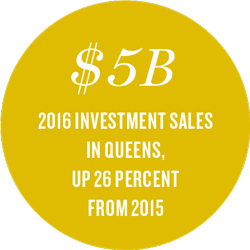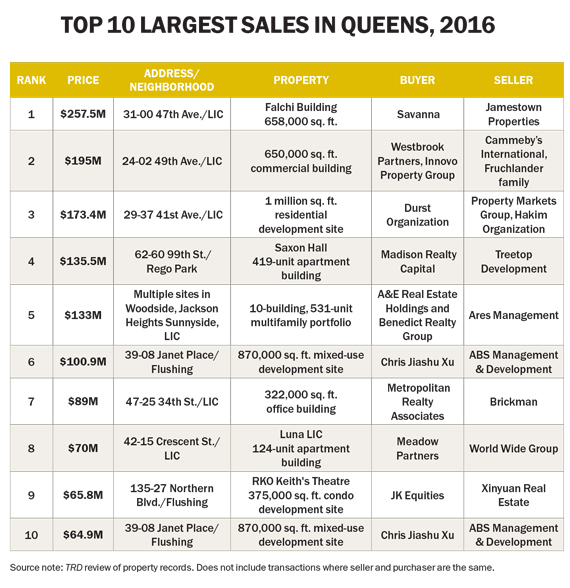Trending
Queens takes the throne
With investors pulling back in NYC, the borough bucked the trend to become the city’s hottest bet in 2016

Last July, Madison Realty Capital [TRDataCustom] ventured as a buyer for the first time into Rego Park, a middle-class neighborhood in the heart of central Queens that has of late seen a flurry of upscale developments. The high-profile investor-lender partnered with Midtown-based investment firm Arel Capital to ring up a $136 million purchase on a 419-unit rental building called Saxon Hall.
The buy turned out to be a record-breaker. Not only was the deal the largest ever transaction in Rego Park, it represented the fourth-largest Queens sale in 2016.
“We thought it was undermanaged compared to what we think we can do,” Madison Realty’s Josh Zegen told The Real Deal last month. “It’s one of those opportunities to get and deliver a renovated, great product that can be a Class-A product at a significant discount.”
He added: “People think there’s still value in Queens.”
Along with A&E Real Estate Holdings and Benedict Realty Group’s $133 million purchase last month for a 10-building portfolio concentrated in Woodside, Jackson Heights, Sunnyside and Elmhurst, Madison Realty’s Rego Park deal suggests that the eternal search for value is leading big-time investors deeper into Queens, past the well-trodden development hotspots of Long Island City and Astoria, where firms like Rockrose Development and the Related Companies have been building megaprojects. Overall, amid a dour year in which investors pulled back the throttle and investment-sales volumes plunged, the city’s geographically largest and most-diverse borough shined: investment sales totals for the borough ended the year at $5 billion, up roughly 26 percent above 2015’s total, according to Cushman & Wakefield. By comparison, the New York City market as a whole saw dollar volumes drop 25 percent, with Manhattan and Brooklyn declining 34 percent and 2 percent, respectively.
At the same time, deals in Queens have gotten much bigger: the number of transactions over $20 million grew from five in 2011 to 42 in 2016, according to Ariel Property Advisors.
Topping the list on last year’s largest sales was Savanna’s $257.5 million purchase in December of the Falchi Building, a 658,000-square-foot office building in Long Island City. The private equity and asset management firm, which is planning on pumping $35 million in infrastructure upgrades, is no stranger to Queens. Back in 2014, Savanna bought a controlling interest for an undisclosed sum in One Court Square, also known as the Citigroup Building, which at 1.5 million square feet represents the biggest office building in Long Island City.
 The firm has also undertaken renovations with properties like the Schlitz Brewery in Bushwick, Brooklyn and Bruckner Building in the South Bronx similar to its plans for the Falchi Building, where it is looking to secure rents of $42 per square foot. Between 2013 and 2016, asking office rents in Long Island City nearly doubled to $38.02 from $19.25, according to JLL. The area is home to companies such as Uber, J. Crew’s Madewell label and JetBlue.
The firm has also undertaken renovations with properties like the Schlitz Brewery in Bushwick, Brooklyn and Bruckner Building in the South Bronx similar to its plans for the Falchi Building, where it is looking to secure rents of $42 per square foot. Between 2013 and 2016, asking office rents in Long Island City nearly doubled to $38.02 from $19.25, according to JLL. The area is home to companies such as Uber, J. Crew’s Madewell label and JetBlue.
In comparison to other submarkets like Williamsburg and Downtown Brooklyn, Long Island City “probably has the most runway,” said Savanna’s managing partner Chris Schlank.
That was clearly the case with Westbrook Partners and investor Andrew Chung’s $195 million purchase last year of a 656,000-square-foot warehouse at 24-02 49th Avenue, which ranked second on the list of top sales. The building’s current tenant, the New York City Housing Authority, is reportedly paying $9 per square foot in rent.
And just last December, the Durst Organization, whose main project in the borough is its $1.5 billion Hallets Point residential development in Astoria, laid out $175 million to buy the Clock Tower development site, which allows for 1 million buildable square feet at the eastern end of Queensboro Plaza. The prior owners Property Markets Group and the Hakim Organization had been planning to develop an 800-unit apartment building but failed to secure a construction loan.
Big players rush in
Long-time owners in the borough have traditionally been reluctant to sell. But Matt Fotis, a broker with Marcus & Millichap, said that’s changing as institutional buyers have started coming in. “Queens as a whole is a pretty low-velocity market,” Fotis said. “There’s probably a third as many transactions that occur in Queens on average compared to Brooklyn. It’s mainly been a local market for so many years, and now finally people from outside are making their first-time purchase in Queens.”
The biggest example is the private equity giant Blackstone, which in mid-2015 paid $400 million to buy the retail portion of the Sky View Parc complex in Flushing.
In 2016, the Asian enclave at the end of the No. 7 Subway line has continued its hot streak. Flushing’s biggest trade of 2016 — the sixth largest in Queens overall — came in December, when active developer Chris Jiashu Xu paid $100.9 million to buy a barren 3.7-acre development site on the edge of the neighborhood next to Sky View Parc. Xu’s plans for the property are not yet clear, but a previous design for the site called for 450 apartments with a hotel and retail space spread across 757,000 square feet.
But among the more significant trends is the growing activity in the multifamily market.
Eric Benaim, CEO of the Long Island City-based residential brokerage Modern Spaces, said that in the further-flung areas of Queens, a developer can purchase a multifamily property at a cap rate of 4 to 6 percent, compared to a 1 or 2 cap they’d pay in Manhattan.
“Right now, if you were to buy a multifamily building in Manhattan, there might not be that much of an upside at the end of the day. In Queens, you can take an older building and renovate it and probably raise rents significantly,” he said.
And, as renters grow increasingly willing to expand their horizons beyond Long Island City, investor interest is now peaking around the largely blue-collar and immigrant neighborhoods of Sunnyside, Woodside, Elmhurst, Jackson Heights and Corona, which are well-positioned along the No. 7 train line. A one-bedroom apartment in Jackson Heights rents for $1,879 per month compared to $2,751 per month in Long Island City, according to MNS.
Stephen Preuss, an investment-sales broker at Cushman & Wakefield who has worked in Queens for 15 years, said he’s never gotten so many calls from developers and owners who are looking to make their first purchase in the borough beyond familiar neighborhoods across the East River. “They’re now calling me and saying, ‘I want to get smart on this part of Queens,’” he said.
Rents in further-flung neighborhoods are starting to rise rapidly. The median price for a one-bedroom in Rego Park, for example, increased 7.46 percent last year to $2,029, according to MNS. That was the biggest increase for one-bedrooms in the entire city last year.
Other noteworthy players in the multifamily market include New Jersey-based landlord Treetop Development. Saxon Hall marked Treetop’s entry into the Queens market in 2013, when it paid $85.25 million for the building. Two years later, it bought an eight-building Queens portfolio in 2015 for nearly $140 million. And just this past August, the firm, using some of money from the Saxon Hall deal, snapped up a 164-unit rental building in East Elmhurst for $41 million as part of a 1031 exchange.
“We were heavily invested in northern Manhattan and in Brooklyn in the Williamsburg-Greenpoint area,” Treetop principal Adam Mermelstein said. “Queens in our mind was sort of a forgotten borough, but still had very good transportation.”
He added: “In Manhattan, you have much older housing stock and it’s been traded again and again. In Queens, a lot of times you’re buying from the original developer. Generally, the capital improvements have been done and it’s been well-maintained.”
Resi market ramps up
While neighborhoods adding new condo inventory like Long Island City and Flushing get a lot of attention, the most active market in Queens belongs to single-and two-family homes.
All told, one- and two-family home sales in the borough accounted for $5.8 billion worth of activity in 2016, according to a review of property records by TRD. By comparison, residential condos fell shy of $900 million worth of sales.
And overall, the number of home sales has continued to climb, keeping inventory down. There were 12,795 residential properties sold in Queens (compared to 9,123 in Brooklyn) in 2016, up 5 percent from the year before, according to Douglas Elliman’s fourth-quarter report.
Meanwhile, the number of listings at the end of the year stood at 3,668, a drop of 22 percent from the end of 2015. At the current rate, it would take only 2.8 months to absorb all the available listings in the borough, the fastest rate of sales since the appraisal firm Miller Samuel began tracking that stat in 2005.
“Right now, we’re very low on inventory,” said Alla Yakubov of the Forest Hills-based brokerage NY Empire Real Estate. “Everything is being sold.”
Brokers say homebuyers looking for value are searching beyond the riverfront neighborhoods, such as Woodhaven in southwest Queens, where modest homes line the blocks adjacent to Forest Park, and Bayside and Whitestone in the northeastern part of the borough, where buyers can find larger, mega-mansion-type homes.
“The Asian market is definitely prominent,” said Allison Gambone of Keller Williams, which closed $833 million worth of sales in Queens last year, the most of any residential brokerage in the borough. “They come in with all-cash offers.”
In fact, an Asian buyer picked up the most-expensive home in Queens last year: a seven-bedroom, 5,200-square-foot, two-story house in Forest Hills that sold in September for $3.35 million.
NY Empire’s Yakubov, who sold the home, said it sits on an irregularly shaped lot, which produced a uniquely large back yard that’s hard to come by. “You could not compare that to any other property,” she said.
Those shopping in Brooklyn will find deals in Queens — although maybe not for long. The median price tag for a one-to-three-family home in Queens was $650,000 last year, compared to $830,000 in Brooklyn. But Queens was growing at a slightly faster clip, up 10.2 percent from a year earlier. The Brooklyn market was up 9.3 percent.
“They’re basically in lockstep,” said Miller Samuel CEO Jonathan Miller, who compiled the Elliman report.
Miller added that the overall residential market in Queens saw average pricing set records in three out of the four quarters last year. And the luxury threshold set a record of $990,000 at the end of the year as it continued to flirt with the $1 million mark.
“Queens was late to the party,” he said. “We saw Brooklyn and Manhattan really jump first, and Queens was a year or two after.”
Development hurdles
Looking ahead, major thoroughfares along the No. 7 train line and Queens Boulevard appear ripe for rezoning. But while developers may be champing at the bit, the process has been notoriously challenging in the borough.
Just ask Related and Sterling Equities. Demolition finally got underway last July at their $4 billion redevelopment of Willets Point after years of court battles and delays. But a proposal by the developers to build a 1.4 million-square-foot mall on the opposite side of Citi Field is still on hold amid litigation over its legality.
And in May, the Department of City Planning hit the pause button on a plan to rezone Flushing West — which could have paved the way for 3,316 new apartments across 11 blocks in Downtown Flushing — amid concerns from local elected officials and community members regarding congestion, pollution in Flushing Creek, and affordability levels.
Even where the city has successfully rezoned neighborhoods, development has sometimes been slow. The city rezoned Sunnyside and Woodside in 2011, but experts say they’ve been slow to take off.
“Growth is slow in Sunnyside, and it’s really frustrating for developers because there’s so much potential,” said Jos Mansell, a broker with Mdrn. Residential.
That’s true as well in neighborhoods like Rego Park, Forest Hills and Kew Gardens — which are well-served by the E and F trains. The thoroughfare Queens Boulevard that runs through those areas includes auto-body repair shops and used-car lots. To any bystander, the landscape presents an obvious opportunity for large-scale assemblages similar to Brooklyn’s Fourth Avenue.
“It’s true that places like Kew Gardens and Forest Hills have very low-density areas that are [next to] transit nodes. And that’s a challenge to planning,” said Mitchell Korbey, chair of the land use and zoning practice at the law firm Herrick Feinstein.
But he said endeavors like the construction of the Cornell Technion Campus on Roosevelt Island, which is already underway, and the city’s plan to study another rezoning for the core of Long Island City should be a boon that reverberates throughout the borough.
Korbey added that many areas of Long Island City and places like industrial parts of Maspeth are zoned for manufacturing use, but could be prime candidates for rezonings that encourage a mix of commercial and residential uses.
Regardless, he said, the growth to date has been undeniable. “You can field a baseball team now that nine Mets players live in Queens,” he said.





